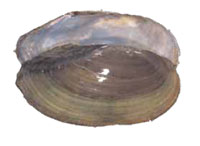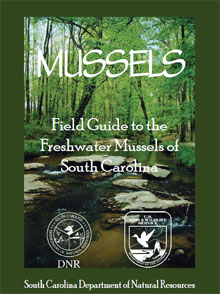Freshwater Fish - Species
Species Specific Regulations
Eastern floater
Freshwater Fishing License required.
Paper pondshell (Utterbackia imbecillis)
Description: (Anatomy of a Shellfish)
The shell is thin, oblong, and inflated. Juveniles, however, are greatly compressed. In especially favorable habitat, individuals may exceed 100 mm in length and become extremely inflated, almost circular in cross section. The Paper Pondshell lacks hinge teeth, and the umbos are flush with the hinge line. The periostracum is yellowish or greenish with numerous fine green rays. The nacre is bluish-white or silvery.
Range: The Paper Pondshell occurs throughout South Carolina and has been reported from the Savannah, Edisto, and Cooper-Santee River basins.
Average Length: 100 mm
Life Expectancy: Approximately 1-10 years
Preferred Habitat
Mussels were historically abundant in most permanent rivers and streams in North America. Sometimes, mussels can be found in temporary bodies of water such as sloughs and oxbow lakes, that occasionally receive water from rivers during flood events. Mussels are not usually found in streams that experience frequent drying or dry periods of long duration.
Food Habits
- Eastern floater are filter feeders that remove particles from the water.
- They feed primarily on phytoplankton (algae), which they filter from the sandy or muddy bottom of streams, lakes, or canals.
Reproduction
- In most species of freshwater mussels, the sexes are separate. Males release sperm into the water column, and females take in the sperm when filtering the water.
- Fertilization occurs internally, and the female mussel remains gravid, anywhere from several weeks to several months.
- Most species of larval mussels, called glochidia, must undergo a parasitic stage in which they attach to the gills or fins of a fish in order to complete development. Some mussel species can use a variety of different fish species as hosts, while others are limited to one or very few fish species.
- In order to increase their chances of finding a suitable host, many female mussels grow an extension of the mantle flap that looks like a small fish, crayfish, insect, or worm to attract a predatory fish host. When the fish attacks, the female releases her glochidia at just the right time.
More information on mussels
Literature Cited
US Geological Survey. NAS Nonindigenous Aquatic Species
http://nas.er.usgs.gov/queries/factsheet.aspx?speciesid=92
Bogan, A. E., J. Alderman, and J. Price. 2008. Field guide to the freshwater mussels of South Carolina. (Adobe PDF - 2MB)
South Carolina Department of Natural Resources, Columbia. 43 pages


